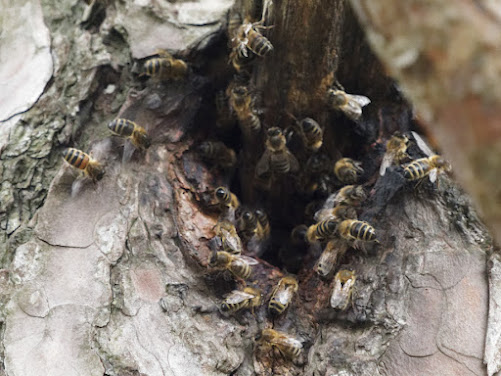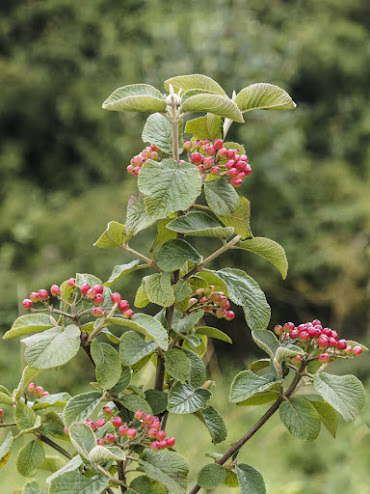This Thursday we have a General Interest walk with Jo Dowle, setting off at 10.00.
Grid ref: SU229122
What3words: skim.desk.vertical
This Thursday we have a General Interest walk with Jo Dowle, setting off at 10.00.
Grid ref: SU229122
What3words: skim.desk.vertical
A cloudy start walking toward Puttles Bridge, the cropped grass speckled with Cats-ear; a Green Woodpecker was glimpsed, a tiny toadlet and Humpback Brittlegill were seen. Among the Scots Pines across the road, Bilberry thriving in the understory, a large Southern Wood Ant’s nest and a variety of fungi including a tired Stinkhorn were spotted.
 |
| Bilberry © Chris Robinson |
 |
| Common Toad © Richard Smith |
Holly Blue © Chris Robinson Unbranched Bur-reed © Chris Robinson
Among the oaks and the odd birch by the bridge were a variety of inaccessible fungi, one possibly an Earthball and another on a Silver Birch, a Dog Vomit Slime Mold.
Along the track through the heather, a Great Spotted Woodpecker was briefly seen and then a New Forest speciality, some Coral-necklace, was spotted growing on a patch of bare damp soil. Leaving the track to go through the wooded area of Holm Hill, many widely spaced ancient Hollies with multiple thick stems were passed, evidently copiced over centuries. A map from 1786 shows the wood, its size and shape much the same as today and with the same track leading to it. Having a biscuit break was accompanied by the sound of some Honey Bees in a nearby nest and a visiting Bee Wolf.
 |
| Honey Bees © Chris Robinson |
 |
| Honey Bees © Richard Smith |
 |
| Bee Wolf © Richard Smith |
Back on the track leading to the bridge over the Silver Stream, a Red Admiral, another Holly Blue, Rove and Dor Beetles, Harebell and a fungus, possibly a Panthercap, were seen.
A Rove Beetle (Staphylinus erythopterus) © Chris Robinson
At the bridge, the sun was now out and dragonflies were flitting about. A young Robin hovered giving a good view and a highly active Keeled Skimmer briefly landed on the path for another view. Also seen were some Oblong-leaved Sundew.
Along the track to the car park, the pollinators were now busy thrumming away, excavated spoil from the holes of Bee Wolves were clearly seen along the sandy edge, a Grayling landed on the bare path and finally one of the several Meadow Pipits paraded on the track to give a splendid view of its plumage. JE
Our route
© Crown copyright 2023 Ordnance Survey.
Media 006/23.
The licence is valid until 31 December 2023
On a cool overcast day, we met at Stockbridge Down, a National Trust managed SSSI comprising a chalky downland habitat with an iron-age hill fort at its summit. We started with good views of a Hummingbird Hawk-moth feeding on Buddleia in the car park.
 |
|
Hummingbird Hawk-moth © Richard Smith |
Aside from assorted Corvid, nothing was flying in the mild, damp conditions as we walked slowly along the western edge of the Down. Amongst the bramble and rabbit burrows, numerous wildflowers and plants were found beside the track. Wild Basil and Wild Marjoram grew profusely along with Common Toadflax, Common Knapweed (rayed form), Common Agrimony, Birds-foot Trefoil, Lady’s Bedstraw, Wild Mignonette and Ragwort. Cinnabar moth caterpillar and Common Soldier Beetle were found on several of the Ragwort, and as the day warmed, we had our first views of Chalk Hill Blue and Gatekeeper butterflies. A Chiffchaff was heard and seen, Eyebright and a few Harebells were added to the plant list, and a Kentish Snail was found attached to a grass stem.
.JPG) |
Chalk Hill Blues © Andy & Sue Skarstein |
 |
Wild Parsnip with Marjoram © Richard Coomber |
 |
Wayfaring Tree fruits © Richard Smith |
Descending the western edge of the Down through areas of coppiced Hazel that were covered with cobnuts this year, we noted a large Yew, Self-heal, Red Bartsia, Musk Thistle, Yarrow, Mullein sp and Rosebay Willowherb. Signs of rapid regeneration of recently cleared areas (to support butterfly habitat) were also noted. Returning towards the car park along The Gallops, an area formerly used to train racehorses, more butterfly emerged including a Large White. Common Carpet, Willow Ermine and Mint Moth were also found. Musk Mallow, Herb Bennet and Fairy Flax were added to the botany count, and a Yellowhammer was heard but not seen.
.JPG) |
Common Carpet © Andy and Sue Skarstein |
 |
Mint Moth © Richard Smith |
 |
Yellowhammer - male with food © Richard Smith |
 |
| Our route © Crown copyright 2023 Ordnance Survey. Media 006/23. The licence is valid until 31 December 2023 |
References